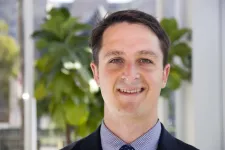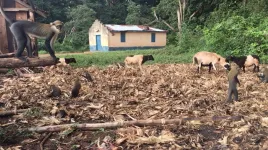(Press-News.org) PITTSBURGH, April 5, 2021 - "Near-poor" Americans--people just above the federal poverty level but still well below the average U.S. income--who rely on Medicare for health insurance face high medical bills and may forgo essential health care, according to new research led by health policy scientists at the University of Pittsburgh Graduate School of Public Health. This is due to a coverage "cliff" in Medicaid, which supplements Medicare for people with incomes below poverty but excludes individuals above the federal poverty threshold, including the near-poor.
In a report published today in the April issue of the journal Health Affairs, the authors describe the effects of this cliff and propose solutions to fix it, with the aim of lessening barriers to care among near-poor people with Medicare.
"Medicaid provides vital assistance to low-income people with Medicare by covering Medicare's high out-of-pocket costs and filling in gaps in Medicare coverage. However, Medicaid's eligibility rules for low-income, older Americans have changed little in 30 years, exclude people barely above poverty, and make it difficult for those below poverty to enroll. As a result, many older Americans who live on modest incomes have difficulty affording care," said lead author Eric T. Roberts, Ph.D., assistant professor in Pitt Public Health's Department of Health Policy and Management. "We're overdue for modernization of the Medicaid program for older adults. The solutions we propose incorporate consumer responsibility while creating substantial improvements in health insurance coverage and access to care."
The near-poor are those whose incomes are between 100% and 200% of the federal poverty level, or $12,880 to $25,760 for a single person in 2021. About 30% of the Medicare population--generally, people who are age 65 or older, and younger people with disabilities--are near-poor. Medicare provides health insurance, but there are still out-of-pocket costs, such as deductibles, copays and premiums. Medicaid--which provides health coverage for people with low income--can serve as a supplemental insurance for Medicare recipients who qualify, covering these out-of-pocket costs.
But near-poor people receiving Medicare generally don't qualify for Medicaid, meaning that they have to purchase alternative supplemental insurance or pay Medicare's costs out-of-pocket. Recent estimates suggest that 40% of near-poor Medicare beneficiaries spend at least one-fifth of their income on health care costs.
Roberts and his team analyzed a diverse sample of 4,602 Medicare beneficiaries with an income less than double the federal poverty line, over multiple years between 2008 and 2016.
They found that 73.3% of Medicare beneficiaries whose incomes were just below Medicaid's eligibility threshold had supplemental health insurance coverage from Medicaid or another source, whereas only 47.5% of the near-poor had such supplemental coverage. The researchers define this 25.8 percentage point difference as "the coverage cliff."
Near-poor beneficiaries affected by this coverage cliff incurred $2,288 in additional out-of-pocket health care spending over two years and were 33.1% more likely to spend more than one month's income on health care costs than their counterparts below the poverty limit.
The team then looked at measures of health care utilization and found that the near-poor used 55% fewer outpatient and preventive health services and filled fewer prescriptions per year, including fewer chronic disease medications.
"These are the kinds of medications and doctor's appointments that help people manage their health conditions and avoid costly hospital care," Roberts said. "But, even more important, prior research has shown that these medications and doctor's appointments can save lives."
Roberts and his colleagues suggest several solutions to mitigate the Medicaid coverage cliff, namely:
Expand Medicaid supplemental coverage to Medicare beneficiaries who make at least 150%, and preferably 200%, of the federal poverty limit.
Offer this coverage on a sliding scale so recipients pay no more than a fixed proportion of their income on Medicare costs.
Simplify Medicaid's application process for seniors, which currently is far more complex than the application process for children and nonelderly adults.
Expand opportunities for qualifying Medicare beneficiaries to enroll in the Medicare Part D "Low-Income Subsidy" to reduce prescription drug costs.
"As the U.S. population ages, analysts forecast a 40% growth in the Medicare population, and that over one-third of Medicare beneficiaries will have low to moderate incomes, making it ever more important to modernize Medicaid now," Roberts said.
INFORMATION:
Additional authors on this research are Alexandra Glynn, Noelle Cornelio, Julie M. Donohue, Ph.D., Walid Gellad, M.D., M.P.H., and Lindsay M. Sabik, Ph.D., all of Pitt; and J. Michael McWilliams, M.D., Ph.D., of Harvard University and Brigham and Women's Hospital.
This research was supported by grants from the Agency for Healthcare Research and Quality (K01HS026727) and the Pitt Pepper Older Americans Independence Center (subaward from National Institute on Aging grant P30 AG024827-13).
To read this release online or share it, visit https://www.upmc.com/media/news/040521-roberts-medicaid-cliff [when embargo lifts].
About the University of Pittsburgh Graduate School of Public Health
The University of Pittsburgh Graduate School of Public Health, founded in 1948 and now one of the top-ranked schools of public health in the United States, conducts research on public health and medical care that improves the lives of millions of people around the world. Pitt Public Health is a leader in devising new methods to prevent and treat cardiovascular diseases, HIV/AIDS, cancer and other important public health problems. For more information about Pitt Public Health, visit the school's Web site at http://www.publichealth.pitt.edu.
http://www.upmc.com/media
PHILADELPHIA-- Approximately 6.5 million people are under correctional supervision in the United States on any given day. Justice-involved individuals (people currently or recently in prison or jail, on probation or parole, or arrested) experience higher rates of substance use disorders than the general population. In fact, among people with opioid use disorder (OUD), more than half have reported contact with the criminal justice system.
Numerous clinical studies have shown that medications for OUD -- specifically, methadone or buprenorphine -- lead to superior outcomes for retention in treatment, reduced illicit opioid use, and decreased opioid-related overdose rates and serious acute care compared with treatments that ...
PHILADELPHIA-- While the emergency department (ED) functions as an integral part of the United States healthcare safety net by handling all medical complaints regardless of insurance status, ED visits are expensive, and many are for lower-acuity conditions that may be amenable to care in other settings. Previous research has suggested that greater availability of urgent care centers - freestanding facilities with extended hours that staff emergency physicians, primary care physicians, or nurse practitioners, and focus on a broad range of lower acuity complaints, like rash, muscle strain, bronchitis, and urinary tract infection - helps decrease ED visits, but whether the centers reduce or increase net spending for patients ...
Even before the pandemic made telehealth a hot topic, people with minor urgent health needs had started to turn to companies that offer on-demand video chats with physicians that they don't normally see.
Insurers and employers even started buying access to this direct-to-consumer form of virtual care, hoping it might reduce in-person care, including emergency department visits.
But a new University of Michigan study casts some doubt on whether that will actually happen.
Published in the April issue of Health Affairs, the study finds that patients who had an on-demand ...
In a new study, researchers found nearly half of those who share explicit images of others without permission feel remorse after the fact and 24% try to deflect blame onto victims. Amy Hasinoff, a researcher at the University of Colorado Denver, joined Danish researcher Sidsel K. Harder, to take a deeper dive into the issue of sexual abuse and image sharing.
Hasinoff and Harder looked at how people who shared explicit images online spoke to police officers about the harmful acts they committed. While looking over cases where the image-sharer was caught and convicted, ...
People with ovarian cancer frequently receive aggressive end-of-life care despite industry guidelines that emphasize quality of life for those with advanced disease, according to a recent study.
In fact, by 2016, ICU stays and emergency department visits in the last month of life had become more common for people with ovarian cancer than they were in 2007, the earliest year from which researchers analyzed data.
The proportion of non-Hispanic Black people who turned to the emergency department for care was even higher -- double that of non-Hispanic whites. Black people were also nearly twice as likely to undergo intensive treatment, including ...
One day, humankind may step foot on another habitable planet. That planet may look very different from Earth, but one thing will feel familiar -- the rain.
In a recent paper, Harvard researchers found that raindrops are remarkably similar across different planetary environments, even planets as drastically different as Earth and Jupiter. Understanding the behavior of raindrops on other planets is key to not only revealing the ancient climate on planets like Mars but identifying potentially habitable planets outside our solar system.
"The lifecycle of clouds is really important when we think about planet habitability," said Kaitlyn Loftus, a graduate student in the Department ...
DURHAM, N.C. -- Integrating the American classroom has long been a goal of many who seek to eradicate racial discrimination. But a new paper from four economists, including Duke University's William A. "Sandy" Darity Jr., suggests that Black students do not always benefit from attending racially balanced schools.
Instead, Black adults who attended racially balanced high schools in the mid-20th century completed significantly less schooling than those who attended either predominantly black or predominantly white schools, the authors found.
"Standard wisdom has it that school desegregation paves the way to racial ...
NEW YORK, APRIL 5, 2021 -- Nine of the hottest years in human history have occurred in the last decade. Without a major shift in this climate trajectory, the future of life on Earth is in question. Should humans, whose fossil-fueled society is driving climate change, use technology to put the brakes on global warming?
Every month since September 2019 the Climate Intervention Biology Working Group, a team of internationally recognized experts in climate science and ecology, has gathered remotely to bring science to bear on that question and the consequences of geoengineering a cooler ...
SARS-CoV-2 showed the world with devastating clarity the threat undetected viruses can pose to global public health. SpillOver, a new web application developed by scientists at the University of California, Davis, and contributed to by experts from all over the world, ranks the risk of wildlife-to-human spillover for newly-discovered viruses.
SpillOver is the first open-source risk assessment tool that evaluates wildlife viruses to estimate their zoonotic spillover and pandemic potential. It effectively creates a watchlist of newly-discovered viruses to help policymakers and health scientists prioritize them for further characterization, surveillance, and risk-reducing interventions.
The tool is linked to a study published in the journal PNAS, in which ...
New Haven, Conn. -- In a new study, Yale Cancer Center researchers have defined the genetic landscape of uterine leiomyosarcomas (uLMS). Furthermore, using fully sequenced patient-derived xenografts, the team has preclinically validated new treatment modalities, which may point to new treatments for uterine cancer. Study results were published online in an early edition of the Proceedings of the National Academy of Science (PNAS).
Uterine cancer is the most common gynecologic malignancy and uterine leiomyosarcomas (uLMS) are highly lethal sarcomas arising from the myometrium, the smooth muscle layer of the uterus. They represent ...

